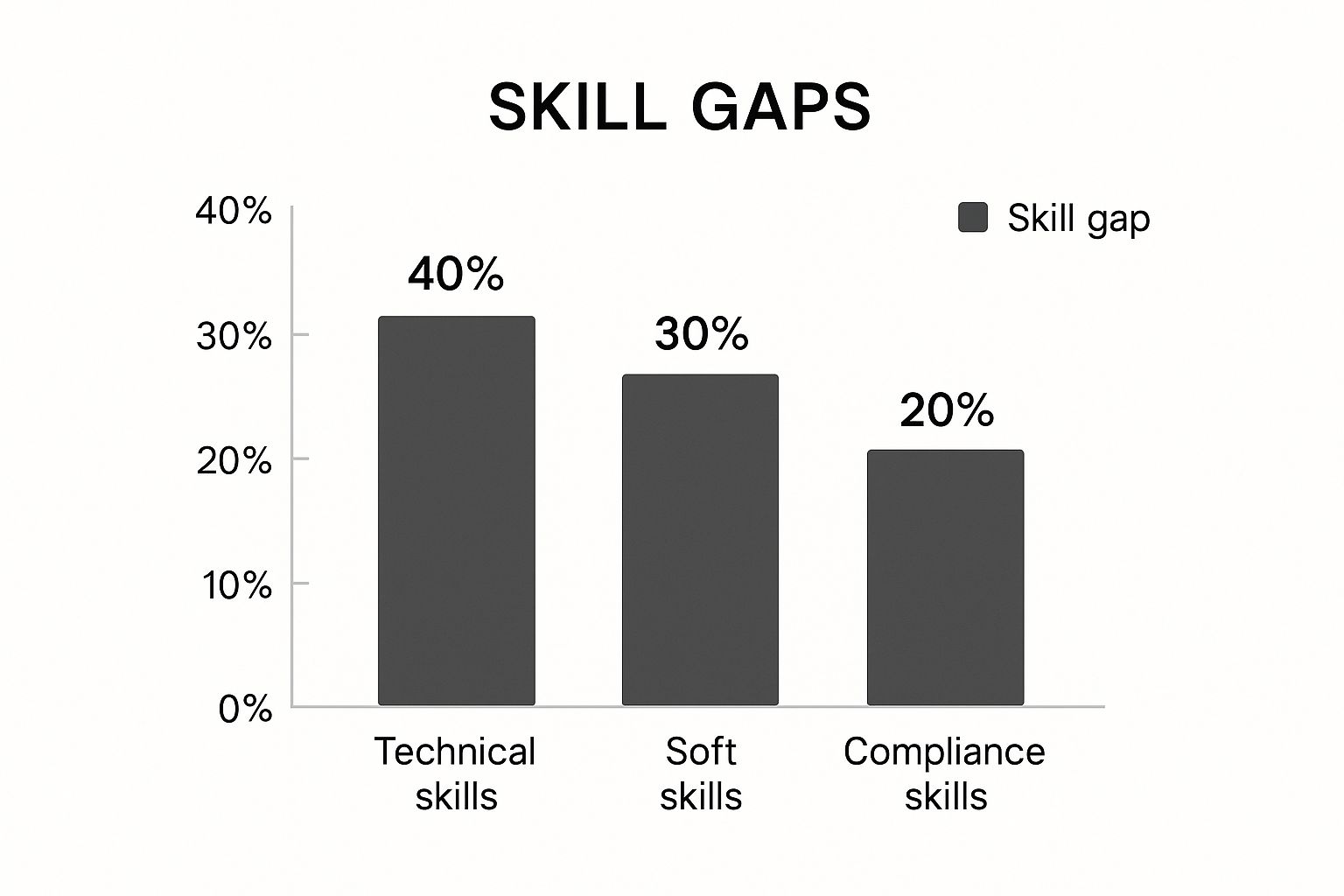Training Needs Analysis: Essential Skills Assessment Tips
Understanding What Makes Training Needs Analysis Actually Work
Let’s be honest – many organizations in India struggle with training needs analysis (TNA). Often, the focus is misplaced. Instead of identifying what employees need to meet business objectives, companies ask what employees want. This creates training programs that are engaging but fail to deliver tangible results. To understand what truly makes TNA effective, we need a change in approach.
A critical first step is differentiating between training needs and wants. Employees might want training on the latest Python libraries, but if their core weakness is project management, that technical training won’t improve performance. Identifying the root cause of performance gaps is key. Addressing the real issue, not just surface-level desires, is the foundation of successful TNA.
Furthermore, a successful TNA should align with overall business goals. Think of a football team. They don’t just practice random drills; they focus on specific plays and strategies needed to win games. Training programs should work the same way, directly contributing to specific business outcomes. This could be anything from boosting client retention to increasing sales.
Another essential component is stakeholder buy-in. From senior management to individual team members, everyone should understand the value and purpose of the TNA. This builds a sense of shared responsibility and ensures the analysis accurately reflects the company’s challenges and potential. Achieving this buy-in requires clear communication and showcasing the benefits of the analysis.
Building a Framework for Success
Effective TNA utilizes proven frameworks that move beyond simple surveys. These frameworks combine quantitative data, like performance metrics and test scores, with qualitative data from interviews and focus groups. This blended approach provides a more complete understanding of skills gaps and training requirements. The U.S. Office of Personnel Management (OPM) emphasizes the importance of these assessments in identifying performance needs and necessary skills for a workforce. This framework is globally applicable, offering guidance for tailoring training programs to specific regional needs. Learn more about effective training programs here.
Assessing and Prioritizing Needs
After data collection comes analysis and prioritization. Not every skill gap carries the same weight. Some directly impact key performance indicators (KPIs), while others are less critical. Prioritizing training based on its potential business impact is essential for maximizing return on investment (ROI).
This involves understanding the company’s strategic goals and aligning training accordingly. For instance, if a company is entering a new market, training on cultural awareness and local regulations would take priority over, say, advanced technical skills. Strategic alignment ensures efficient use of training resources.
Finally, effective TNA is not a one-time activity. It’s an ongoing cycle of assessment, analysis, and adjustment. Workforce needs are constantly changing, and training programs must adapt. By creating a system for continuous TNA, organizations ensure their employees possess the necessary skills to succeed in a dynamic environment. This commitment to ongoing improvement distinguishes effective TNA from a mere formality.
Why Regional Differences Matter More Than You Think

Many training programs miss the mark by taking a one-size-fits-all approach. They often overlook the significant impact of regional differences. This can lead to programs that are successful at headquarters but struggle elsewhere. This section explores why considering regional nuances in India is vital for training needs analysis (TNA).
Understanding The Impact of Regional Variations
Consider the difference between the IT sector in Bengaluru and the textile industry in Tiruppur. Each region has a unique economic landscape that influences required skill sets and training approaches. A Bengaluru tech company might prioritize training on the latest software, while a Tiruppur textile factory might focus on traditional craftsmanship combined with modern machinery operation.
Cultural factors also play a role. Training delivered in Hindi in Uttar Pradesh might not be effective if delivered the same way in Tamil Nadu. Adapting training delivery to resonate with local customs and languages is crucial for engagement and knowledge retention. Understanding local nuances and communication styles is key to this adaptation.
Practical Methods For Region-Specific Evaluations
Successful organizations recognize these regional differences and adapt their TNA accordingly. They use practical methods for region-specific evaluations. These methods account for local industry clusters, educational infrastructure, and workforce characteristics.
- Local Industry Analysis: Analyzing the dominant industries in a region helps identify specific skill demands. This informs the development of targeted training programs aligned with industry requirements.
- Educational Infrastructure Assessment: Understanding the quality and availability of education in a specific region allows for training that addresses existing knowledge gaps. This ensures the training program is accessible and relevant.
- Workforce Characteristic Research: Examining demographics, employment rates, and existing skills within a region provides valuable context for designing effective training. This research helps avoid mismatches between training content and workforce readiness.
In the context of TNA, the Public Health Workforce Interests and Needs Survey (PH WINS) 2017 offers valuable insights into skill gaps across different regions in the United States. This survey highlights substantial interregional differences. It indicates that current infrastructure might not have the capacity to address contemporary health challenges. Learn more about regional training needs assessments here.
Standardizing Vs. Customizing Training
A key aspect of regionalizing TNA is deciding what can be standardized and what needs customization. Some core competencies, such as communication and teamwork, can often be standardized. However, technical skills or industry-specific knowledge frequently require customization based on local needs. Finding this balance optimizes training effectiveness while managing costs and resources.
The Benefits of Regionalized TNA
A regional approach to TNA offers several advantages. It ensures training programs are relevant, engaging, and effective across different locations. By addressing each region’s unique needs, organizations maximize their return on investment in training.
This targeted approach also improves employee performance and contributes to overall business success. Instead of a generic program, employees receive training specific to their challenges. This leads to greater job satisfaction and improved outcomes. Regional insights are essential for successful training initiatives that contribute to both individual and organizational growth throughout India.
Getting Real Data That Actually Matters
Forget generic surveys that offer little valuable information. Effective training needs analysis (TNA) requires a strategic approach to data collection. You need to uncover genuine training needs, not just surface-level preferences. This means understanding why typical surveys fail and how to design questions that reveal the true gap between current performance and desired outcomes.
Designing Effective Data Collection Strategies
One common reason surveys miss the mark is low response rates. If only a small, self-selected group participates, the data won’t accurately represent the entire workforce. Proven techniques can drastically improve participation and ensure a representative sample. These include personalized invitations, clearly communicating the survey’s purpose, and sending follow-up reminders.
Another crucial aspect is crafting effective questions. Instead of asking, “What training do you want?”, focus on performance-based questions. For example, consider questions like, “What challenges do you face when completing Task X?” or “What skills would improve your performance in Area Y?” This approach reveals the specific skills and knowledge gaps hindering performance.
The following infographic illustrates the typical distribution of skill gaps:

As shown, technical skills (40%) represent the largest area where skill gaps exist, followed by soft skills (30%) and compliance skills (20%). This highlights the need for TNA to address a range of skill sets, not just technical expertise.
Combining Quantitative and Qualitative Insights
Effective TNA combines quantitative metrics with qualitative insights. Quantitative data, like performance scores and assessment results, provides measurable data. Qualitative data from interviews and focus groups adds important context and depth. This blended approach offers a more complete picture, uncovering the root causes behind performance gaps.
For example, low sales numbers (quantitative data) could stem from various factors: a lack of product knowledge, ineffective sales techniques, or even external market forces. Interviews with sales representatives (qualitative data) can pinpoint the specific reasons, enabling more targeted training solutions.
The Region V Public Health Training Center’s 2020 needs assessment demonstrated this. With a 58% response rate, the survey highlighted several key areas.
To present these findings clearly, let’s look at the following table:
“Training Needs Priority Areas by Response Rate” Breakdown of key training support areas identified through comprehensive needs assessment
| Training Category | Percentage of Responses | Priority Level |
|---|---|---|
| Any Assistance | 26% | High |
| Secure Funding | 12% | Medium |
| Technical Training | 12% | Medium |
| Time Management | 12% | Medium |
This data reveals the importance of addressing both systemic needs (like assistance and funding) and specific skill development (such as technical training and time management) for effective training. Learn more about the Region V Public Health Training Center’s needs assessment here. You can also explore the India Skills Reports for additional context.
Turning Data Into Actionable Insights
The ultimate goal of TNA is to transform data into strategic insights that drive effective training programs. This involves developing practical frameworks for analyzing survey responses, identifying key trends, and prioritizing training needs based on business impact and feasibility.
By focusing on actionable data, organizations can avoid wasting time on meaningless metrics. Instead, they can invest in training that delivers tangible results. This focused approach ensures that training programs address the most critical needs, leading to improved performance and a stronger return on investment.
Spotting the Skills Gaps That Actually Impact Performance

Not all skills gaps are the same. Trying to fix every single one through training is expensive and inefficient. This section explains how to identify the skills gaps that truly affect performance. We’ll also explore how to distinguish these crucial gaps from areas where improvement, while helpful, isn’t essential for success. This focused approach ensures your training budget is used wisely.
The Difference Between Critical Gaps and Nice-to-Haves
Understanding the core requirements of each role within your organization is the first step. It’s similar to a doctor diagnosing a patient. Doctors don’t simply treat every symptom; they look for the root cause of the illness. Likewise, a training needs analysis (TNA) should uncover the underlying reasons for performance issues. It’s not enough to address surface-level problems.
For example, imagine a sales team consistently missing its targets. Additional product training might seem like a logical solution. However, the real issue could be a lack of effective communication skills or a weak lead qualification process. Addressing these core issues will yield much better results than simply increasing product knowledge.
Using Job Analysis and Subject Matter Experts
Job analysis provides a structured method for defining the knowledge, skills, and abilities (KSAs) necessary for each role. This process involves breaking down each job into its key tasks and identifying the competencies needed for success. Collaborating with subject matter experts (SMEs) adds significant value to this process. SMEs possess deep knowledge and experience in specific areas. They can provide valuable insights into what truly defines competence, moving beyond general descriptions to establish realistic performance standards.
Recognizing Systemic Issues
Sometimes, performance problems aren’t caused by individual skill deficiencies. Instead, they might stem from systemic issues within the organization itself. These could include inefficient processes, a lack of necessary resources, or unclear communication. This is especially important in hierarchical organizational structures where workflow can be impeded. In these cases, additional training won’t solve the problem. The solution lies in addressing the underlying systemic issues. For instance, equipping a sales team with the latest CRM software won’t be effective if the company’s internal data management processes are flawed.
Prioritizing Skills Gaps: A Strategic Approach
Once skills gaps have been identified, prioritizing them based on their impact on the business is crucial. This ensures training resources are focused on areas that will provide the greatest return. A well-designed TNA prioritizes gaps based on several key factors:
- Business Impact: How does the gap affect key performance indicators (KPIs) such as revenue, customer satisfaction, or project deadlines?
- Implementation Feasibility: How easy and cost-effective is it to address the gap through training?
- Resource Constraints: Are there sufficient budget, time, and staff available to implement the necessary training?
By using this strategic prioritization approach, you can ensure that your training recommendations address the root causes of performance issues. Organizations that use a systematic approach to skills gap analysis achieve 67% better training ROI and see 45% faster performance improvement than those relying on ad-hoc methods. Find more detailed statistics here. This data-driven approach aligns your training initiatives with your overall business objectives, maximizing their impact on your organization’s success.
Building Training Recommendations That Get Approved
You’ve pinpointed your organization’s skill gaps. Now comes the crucial next step: securing leadership buy-in and investment for training solutions. This section explains how successful training professionals in India transform training needs analysis (TNA) findings into persuasive business cases that get approved. It’s not just about presenting data; it’s about crafting a compelling narrative that resonates with decision-makers and showcases a clear return on investment.
Quantifying the Cost of Inaction
A cornerstone of any successful proposal is quantifying the cost of not investing in training. This involves demonstrating how skill gaps directly impact important business metrics.
For instance, if your TNA reveals weak customer service skills, calculate the potential revenue lost due to poor customer retention. If there’s a gap in technical skills, estimate the productivity loss due to inefficient processes. Putting a monetary value on these consequences makes the impact of inaction crystal clear for leadership.
Presenting Clear ROI Projections
Besides showing the cost of inaction, you must present clear ROI projections for the proposed training. This means estimating the positive impact of training on key performance indicators (KPIs).
For example, if you’re suggesting sales training, project the potential increase in sales revenue. If you’re recommending leadership development, estimate the improvements in team performance and employee retention. These projections should be rooted in data and realistic expectations, giving decision-makers confidence that the training investment will deliver tangible results.
Matching Training Methods to Needs and Budget
Different training methods have varying levels of effectiveness, cost, and implementation time. Choosing the right method is vital for maximizing ROI. Online courses might work well for basic technical skills, while in-person workshops might be better for leadership development or soft skills training.
To help illustrate the differences, let’s look at the comparison table below:
To understand these varying approaches, the following table provides a comparison of different training delivery methods based on their effectiveness, cost, and implementation requirements:
Training Delivery Methods Comparison:
| Delivery Method | Best Use Cases | Cost Level | Implementation Time | Effectiveness Rating |
|---|---|---|---|---|
| Online Courses | Basic Technical Skills, Compliance Training | Low | Short | Moderate |
| In-Person Workshops | Leadership Development, Soft Skills, Team Building | High | Moderate | High |
| On-the-Job Training | Practical Skills Application, Mentorship | Moderate | Moderate | High |
| Blended Learning | Combining various methods for a comprehensive approach | Moderate | Moderate | High |
Matching the appropriate method to the specific needs, learner preferences, and budget realities ensures efficient use of resources and maximizes training effectiveness.
Developing Phased Implementation Plans
Instead of proposing a large, all-at-once training program, think about a phased implementation plan. This allows for quick wins, demonstrating progress early and securing support for future phases.
Start by tackling the most critical skill gaps that have the highest potential for immediate impact. If customer service is a significant issue, begin with that training and track the resulting improvement in customer satisfaction. These initial successes can then be used to justify further investment in later training phases.
Creating Accountability and Success Metrics
Finally, incorporate accountability measures and success metrics into your training recommendations. This goes beyond participant satisfaction surveys. Instead, establish clear metrics that gauge actual behavior change and performance improvement.
For example, track sales figures after sales training or evaluate employee engagement following leadership development programs. This data-driven approach demonstrates training effectiveness and validates continued investment in future initiatives. You might find this resource helpful: How to master your career path. By converting training needs analysis findings into specific, measurable solutions, you create strong proposals that secure leadership approval and build the foundation for impactful training programs.
Proving Your Training Actually Worked

Too often, training programs in India struggle to show tangible benefits. Many rely solely on participant satisfaction surveys, which don’t always reflect actual performance improvements. This section explores practical ways to measure training effectiveness beyond simple feedback forms. The goal is to shift from subjective opinions to objective data that showcases real change.
Establishing Meaningful Baseline Metrics
Before launching any training program, setting a baseline is essential. This means measuring key performance indicators (KPIs) before training starts. This initial data acts as a benchmark to measure the training’s true effect.
For example, if the training aims to boost sales conversion rates, track the current rate beforehand. This gives you a clear starting point to evaluate improvements. If the training focuses on customer service, measure existing customer satisfaction scores to establish your baseline.
Tracking Behavior Change and Performance Improvement
Effective training evaluation goes beyond simply testing knowledge gained during the program. It involves tracking observable changes in employee behavior and the resulting performance gains. This means seeing how employees apply new skills on the job and how that translates into tangible results.
Here are some effective methods:
- Observation: Directly watch employees perform their tasks.
- Performance Data Analysis: Analyze KPIs before and after training.
- 360-Degree Feedback: Gather input from supervisors, peers, and team members.
- Post-Training Assessments: Evaluate skill application in realistic work scenarios.
For instance, if the training focused on team collaboration, observe team meetings for better communication. Track project completion rates and team performance metrics to gauge the training’s real-world impact.
Evaluation Methodologies and ROI
Organizations that consistently demonstrate training return on investment (ROI) use robust evaluation methods. These involve selecting the right metrics and analyzing data to isolate the training’s impact from other influences. This can be tricky, as numerous factors affect performance.
One effective approach is using a control group. Compare the performance of trained employees with a similar group who didn’t receive training. This helps pinpoint whether the training drove the observed improvements.
Follow-up evaluations several months post-training are also valuable. This assesses the training’s long-term impact and highlights areas where refresher courses might be beneficial. You might be interested in: How to master recruitment.
Feedback Loops and Continuous Improvement
Establish feedback loops for continuous improvement. Collect feedback from participants, trainers, and managers to identify areas for enhancement. Combine this feedback with performance data to adjust training content, delivery methods, and evaluation strategies. This iterative process ensures the program stays relevant and effective.
Communicating Training Impact
Finally, effectively communicate the training’s impact to stakeholders. Present data clearly and concisely, emphasizing the positive changes resulting from the training. Focus on the training’s contribution to business objectives and how it helped the organization achieve its goals. This clear communication secures continued support and resources for future training initiatives. By demonstrating the value of training, you cultivate a culture of learning and development that benefits both individual employees and the organization overall.
Key Takeaways
A successful Training Needs Analysis (TNA) is crucial for developing training programs that hit the mark and boost organizational success. This section summarizes the key takeaways from this post, providing a practical roadmap for implementing TNA in your organization. These insights will give you the tools and knowledge to build a sustainable system for ongoing needs assessment, moving from a one-time project to a cycle of continuous improvement.
Defining a Successful Training Needs Analysis
An effective TNA begins with understanding the difference between training needs and training wants. It’s about going beyond simply asking employees what training they desire and focusing on what they need to perform optimally and achieve business objectives. This shift aligns training initiatives with strategic goals, much like a cricket team uses specific strategies and training drills to win matches.
The Importance of Regional Nuances
Regional differences play a significant role in TNA. The skills gap in a tech hub like Bengaluru will differ greatly from that in a manufacturing center like Ludhiana. A good TNA considers these variations, adapting training programs to local industry needs, educational infrastructure, and workforce characteristics. This could involve customizing certain modules while keeping core elements standardized for optimal relevance and efficiency.
Gathering Data That Drives Action
Data collection shouldn’t be just a box to tick. Generic surveys often miss the mark on providing actionable insights. Instead, design questions that uncover the true gaps between current performance and desired outcomes. Combining quantitative data with qualitative insights from interviews and focus groups paints a more complete picture of the underlying issues.
Prioritizing Gaps for Maximum Impact
Not all skill gaps are equal. Prioritize them based on their influence on key performance indicators (KPIs) and business objectives. This might involve conducting a thorough job analysis, working with subject matter experts (SMEs), and analyzing performance data to pinpoint the skills essential for success.
Building a Compelling Case for Training
Getting leadership buy-in requires presenting TNA findings as a strong business case. Quantify the cost of inaction and clearly show ROI projections for proposed training. Aligning training methods with specific needs and budget realities—whether it’s online learning platforms like Coursera, in-person workshops, or a blended approach—maximizes efficiency and ensures relevance.
Measuring and Demonstrating Real Results
Demonstrating training effectiveness goes beyond simple satisfaction surveys. Establish meaningful baseline metrics before training and track actual behavior change and performance improvement afterward. Robust evaluation methods, such as using a control group and post-training assessments, isolate the impact of training from other factors.
Creating a Sustainable System
Finally, establish a system for ongoing needs assessment with a feedback loop for continuous improvement. Regularly revisit and refine your TNA process based on data, feedback, and shifting business objectives. This fosters a culture of learning and adaptation, ensuring your workforce stays ahead of evolving challenges.
Are you ready to transform your organization’s learning and development strategy? Taggd offers expert Recruitment Process Outsourcing (RPO) services to help you find the right talent and develop your workforce effectively. Visit Taggd to learn more about how we can help you build a high-performing team and achieve your business goals.
